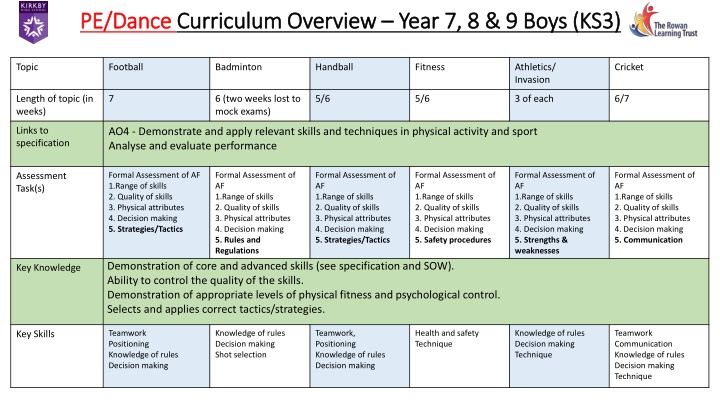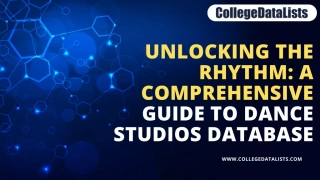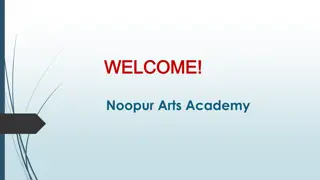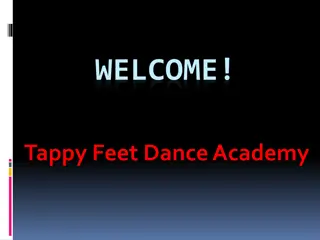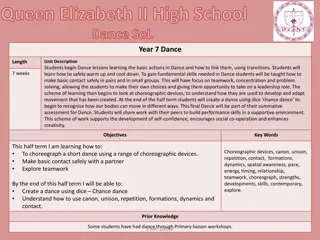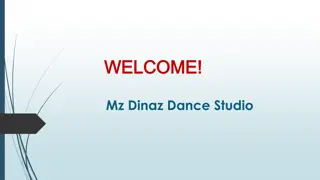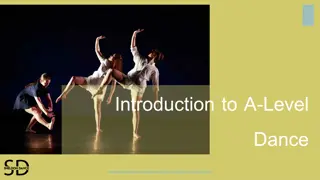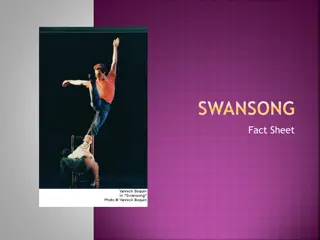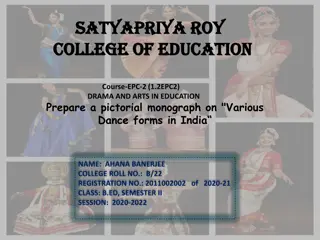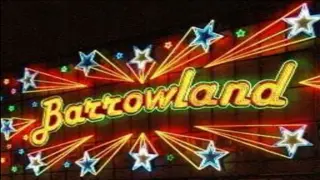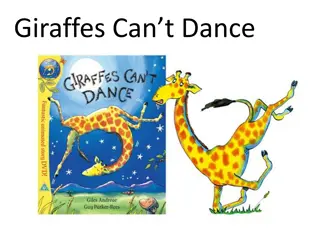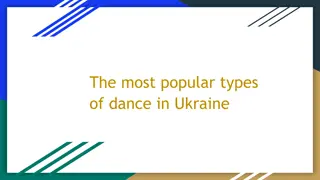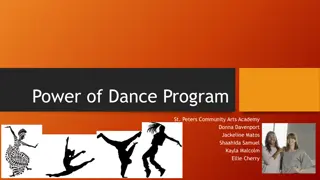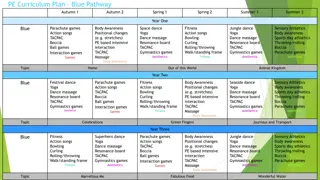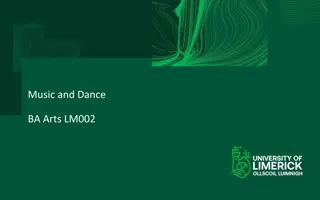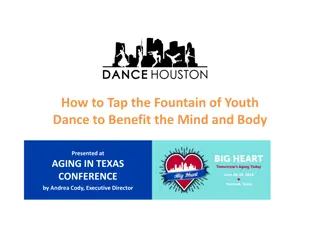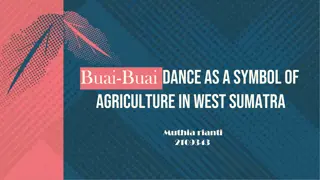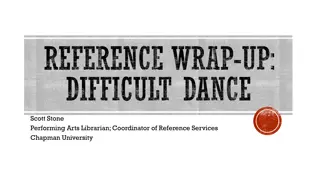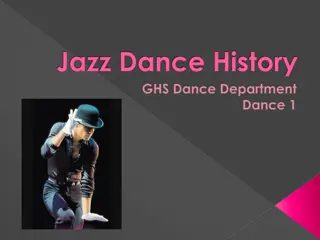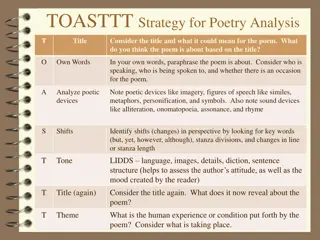Physical Education and Dance Curriculum Overview
This curriculum overview provides a detailed breakdown of topics, assessment criteria, key knowledge, skills, and assessment tasks for boys and girls in Year 7, 8, and 9 of Key Stage 3 (KS3). The curriculum covers a variety of sports such as football, badminton, handball, netball, dance, fitness, and more, focusing on skills development, physical attributes, decision-making, strategies, teamwork, and techniques. Students are assessed on their range and quality of skills, physical attributes, decision-making abilities, strategies, and communication skills, with a strong emphasis on performance evaluation.
Download Presentation

Please find below an Image/Link to download the presentation.
The content on the website is provided AS IS for your information and personal use only. It may not be sold, licensed, or shared on other websites without obtaining consent from the author.If you encounter any issues during the download, it is possible that the publisher has removed the file from their server.
You are allowed to download the files provided on this website for personal or commercial use, subject to the condition that they are used lawfully. All files are the property of their respective owners.
The content on the website is provided AS IS for your information and personal use only. It may not be sold, licensed, or shared on other websites without obtaining consent from the author.
E N D
Presentation Transcript
PE/Dance PE/Dance Curriculum Overview Curriculum Overview Year 7, 8 & 9 Boys (KS3) Year 7, 8 & 9 Boys (KS3) Topic Football Badminton Handball Fitness Athletics/ Invasion Cricket Length of topic (in weeks) 7 6 (two weeks lost to mock exams) 5/6 5/6 3 of each 6/7 Links to specification AO4 - Demonstrate and apply relevant skills and techniques in physical activity and sport Analyse and evaluate performance Formal Assessment of AF 1.Range of skills 2. Quality of skills 3. Physical attributes 4. Decision making 5. Strategies/Tactics Formal Assessment of AF 1.Range of skills 2. Quality of skills 3. Physical attributes 4. Decision making 5. Rules and Regulations Formal Assessment of AF 1.Range of skills 2. Quality of skills 3. Physical attributes 4. Decision making 5. Strategies/Tactics Formal Assessment of AF 1.Range of skills 2. Quality of skills 3. Physical attributes 4. Decision making 5. Safety procedures Formal Assessment of AF 1.Range of skills 2. Quality of skills 3. Physical attributes 4. Decision making 5. Strengths & weaknesses Formal Assessment of AF 1.Range of skills 2. Quality of skills 3. Physical attributes 4. Decision making 5. Communication Assessment Task(s) Demonstration of core and advanced skills (see specification and SOW). Ability to control the quality of the skills. Demonstration of appropriate levels of physical fitness and psychological control. Selects and applies correct tactics/strategies. Key Knowledge Teamwork Positioning Knowledge of rules Decision making Knowledge of rules Decision making Shot selection Teamwork, Positioning Knowledge of rules Decision making Health and safety Technique Knowledge of rules Decision making Technique Teamwork Communication Knowledge of rules Decision making Technique Key Skills
PE/Dance PE/Dance Curriculum Overview Curriculum Overview Year 7 & 8 Girls (KS3) Year 7 & 8 Girls (KS3) Topic Netball Dance Fitness Badminton Invasion/ Athletics Rounders Length of topic (in weeks) 7 8 5/6 5/6 3 of each 6/7 Links to specification AO4 - Demonstrate and apply relevant skills and techniques in physical activity and sport Analyse and evaluate performance Formal Assessment of AF 1.Range of skills 2. Quality of skills 3. Physical attributes 4. Decision making 5. Strategies/Tactics Formal Assessment of AF 1.Range of skills 2. Quality of skills 3. Physical attributes 4. Decision making 5. Strengths & weaknesses Formal Assessment of AF 1.Range of skills 2. Quality of skills 3. Physical attributes 4. Decision making 5. Safety procedures Formal Assessment of AF 1.Range of skills 2. Quality of skills 3. Physical attributes 4. Decision making 5. Rules and Regulations Formal Assessment of AF 1.Range of skills 2. Quality of skills 3. Physical attributes 4. Decision making 5. Strengths & weaknesses Formal Assessment of AF 1.Range of skills 2. Quality of skills 3. Physical attributes 4. Decision making 5. Communication Assessment Task(s) Demonstration of core and advanced skills (see specification and SOW). Ability to control the quality of the skills. Demonstration of appropriate levels of physical fitness and psychological control. Selection and application of correct tactics/strategies. Key Knowledge Teamwork Positioning Knowledge of rules Decision making Creativity Control Rhythm Timing Aesthetics Health and safety Technique Knowledge of rules Decision making Shot selection Knowledge of rules Decision making Technique Teamwork Communication Knowledge of rules Decision making Technique Key Skills
PE/Dance curriculum overview PE/Dance curriculum overview Year 9 (KS3) Year 9 (KS3) Topic Year 9 Choreography Year 9 Choreography Year 9 Performance Year 9 Performance Year 9 Critical appreciation/performance A Linha Curva Year 9 Choreography HT1 - 7 weeks HT1 7 weeks HT2 SOLO SET PHRASE Breathe 6 weeks HT2 6 weeks HT3 6 weeks HT3 6 weeks Length of topic (in weeks) AO2/3 Create dance, including movement material and aural setting, to communicate choreographic intention AO2/3 Create dance, including movement material and aural setting, to communicate choreographic intention AO1/3 Perform dance, reflecting choreographic intention through physical, technical and expressive skills AO1/3 Perform dance, reflecting choreographic intention through physical, technical and expressive skills GREATEST SHOWMAN AO4/2 - Critically appreciate own works and professional works through analytical, interpretative and evaluative judgements. A LINHA CURVA AO2/3 Create dance, including movement material and aural setting, to communicate choreographic intention Links to specification Creative choreography actions/dynamics/ Stage criteria Weekly teacher assessment Creative choreography space and relationships. Stage criteria Weekly teacher assessment Introduction to Breathe End of unit performance task Stage criteria Video use to link to GCSE confidence End of unit performance task Stage criteria Video use to link to GCSE confidence Weekly teacher assessment A Linha Curva practical task Stage criteria Weekly teacher assessment Creative choreography stimulus development Assessment Task(s) Stage criteria Weekly teacher assessment Action, Dynamics, Space, Relationships. Processes-researching, generating, selecting, developing, refining and synthesising. Action, Dynamics, Space, Relationships. Processes-researching, generating, selecting, developing, refining and synthesising. Physical skills and attributes Technical skills and attributes Physical skills and attributes Technical skills and attributes Expressive skills and attributes Mental skills and attributes A Linha Curva Critically appreciate aspects of A Linha Curva as professional works Motif development, repetition, contrast, highlights, climax, manipulation of number, unison and canon Key Knowledge -creative and imaginative response to range of stimuli -use of imagination, problem solving, creativity and synthesis of ideas -application of knowledge, skills and understanding of choreographic forms and devices -communication of ideas, feelings, emotions, meanings and moods -creative and imaginative response to range of stimuli -use of imagination, problem solving, creativity and synthesis of ideas -application of knowledge, skills and understanding of choreographic forms and devices -communication of ideas, feelings, emotions, meanings and moods -application of knowledge, skills and understanding for performing -development of physical, technical, mental and expressive skills. -communication of choreographic intention and artistry -application of knowledge, skills and understanding for performing -development of physical, technical, mental and expressive skills. -communication of choreographic intention and artistry -articulation of knowledge and critical reflection to inform, artistic process. -critical appreciation of dance in its physical, artistic, aesthetic and cultural contexts. -critical analysis, interpretation, evaluation and appreciation of professional works. -creative and imaginative response to range of stimuli -use of imagination, problem solving, creativity and synthesis of ideas -application of knowledge, skills and understanding of choreographic forms and devices -communication of ideas, feelings, emotions, meanings and moods Key Skills
PE/Dance curriculum overview PE/Dance curriculum overview Year 9 (KS3) Year 9 (KS3) Topic Year 9 Choreography Year 9 Performance Year 9 Dance Leaders Year 9 Critically appreciate own works and professional works Shadows Year 9 Performance Length of topic (in weeks) HT4 -commercial 6 weeks HT4 Solo set phrase Scoop 6 weeks HT5 x 2lessons 6 weeks HT6 6 weeks HT6 intro to duet/trio (GCSE) Links to specification AO2/3 Create dance, including movement material and aural setting, to communicate choreographic intention AO1/3 Perform dance, reflecting choreographic intention through physical, technical and expressive skills Dance leaders unit (sports leaders UK) AO4/2 - Critically appreciate own works and professional works through analytical, interpretative and evaluative judgements .Shadows AO1/3 Perform dance, reflecting choreographic intention through physical, technical and expressive skills Assessment Task(s) Creative choreography choreographic devices Stage criteria Weekly teacher assessment Introduction to Scoop End of unit performance task Stage criteria Video use to link to GCSE confidence Deliver warm up and short choreography phrase to Year 7/primary Weekly teacher assessment Creative choreography task using Shadows as stimulus Weekly teacher assessment Introduction to duet/trio Stage criteria Video use to link to GCSE confidence Weekly teacher assessment Key Knowledge Motif development, repetition, contrast, highlights, climax, manipulation of number, unison and canon Physical skills and attributes Technical skills and attributes Expressive skills and attributes Mental skills and attributes Physical skills and attributes Technical skills and attributes Expressive skills and attributes Mental skills and attributes Shadowss Critically appreciate aspects of Shadows as professional works Physical skills and attributes Technical skills and attributes Expressive skills and attributes Mental skills and attributes Key Skills -creative and imaginative response to range of stimuli -use of imagination, problem solving, creativity and synthesis of ideas -application of knowledge, skills and understanding of choreographic forms and devices -communication of ideas, feelings, emotions, meanings and moods -application of knowledge, skills and understanding for performing -development of physical, technical, mental and expressive skills. -communication of choreographic intention and artistry -application of knowledge, skills and understanding for performing -development of physical, technical, mental and expressive skills. -communication of choreographic intention and artistry -articulation of knowledge and critical reflection to inform, artistic process. -critical appreciation of dance in its physical, artistic, aesthetic and cultural contexts. -critical analysis, interpretation, evaluation and appreciation of professional works. -application of knowledge, skills and understanding for performing -development of physical, technical, mental and expressive skills. -communication of choreographic intention and artistry
PE/Dance curriculum overview PE/Dance curriculum overview Year 9 Year 9 Year 9 Dance enrichment: Dance leaders unit LIPA enrichment workshop Dance clubs Opportunity to watch Year 10/11 dancers
PE/Dance curriculum overview PE/Dance curriculum overview Year 10 (KS4) Year 10 (KS4) Exam board: AQA Exam board: AQA GCSE Dance(8236) GCSE Dance(8236)
PE/Dance curriculum overview PE/Dance curriculum overview Year 10 (KS4) Year 10 (KS4) Exam board: AQA GCSE Dance(8236) Exam board: AQA GCSE Dance(8236) Topic Year 10 Choreography Year 10 Performance Year 10 Performance Year 10 Critically appreciate own works and professional works A Linha Curva Year 10 Critically appreciate own works and professional works Shadows Length of topic (in weeks) HT1/HT2 12 weeks HT1 6 weeks HT2 6 weeks HT1 6 weeks HT2 6 weeks Links to specification AO2/3 Create dance, including movement material and aural setting, to communicate choreographic intention AO1/3 Perform dance, reflecting choreographic intention through physical, technical and expressive skills AO1/3 Perform dance, reflecting choreographic intention through physical, technical and expressive skills AO4 - Critically appreciate own works and professional works through analytical, interpretative and evaluative judgements. A LINHA CURVA AO4 - Critically appreciate own works and professional works through analytical, interpretative and evaluative judgements. SHADOWS Assessment Task(s) Creative choreography actions/dynamics/space and relationships. DUET. GCSE criteria /16. Mock performance duet/trio GCSE Criteria /24 Mock performance SOLO SET PHRASE GCSE Criteria /12 Week 5 6 exam style question Week 6 MAD time Week 5 6 exam style question Week 6 MAD time Key Knowledge Action, Dynamics, Space, Relationships. Processes-researching, generating, selecting, developing, refining and synthesising. Physical skills and attributes Technical skills and attributes Expressive skills and attributes Mental skills and attributes Physical skills and attributes Technical skills and attributes Expressive skills and attributes Mental skills and attributes A Linha Curva Critically appreciate all aspects of A Linha Curva as professional works Shadows Critically appreciate all aspects of Shadows as professional works Key Skills -creative and imaginative response to range of stimuli -use of imagination, problem solving, creativity and synthesis of ideas -application of knowledge, skills and understanding of choreographic forms and devices -communication of ideas, feelings, emotions, meanings and moods -application of knowledge, skills and understanding for performing -development of physical, technical, mental and expressive skills. -communication of choreographic intention and artistry -application of knowledge, skills and understanding for performing -development of physical, technical, mental and expressive skills. -communication of choreographic intention and artistry -articulation of knowledge and critical reflection to inform, artistic process. -critical appreciation of dance in its physical, artistic, aesthetic and cultural contexts. -critical analysis, interpretation, evaluation and appreciation of professional works. -articulation of knowledge and critical reflection to inform, artistic process. -critical appreciation of dance in its physical, artistic, aesthetic and cultural contexts. -critical analysis, interpretation, evaluation and appreciation of professional works.
PE/Dance curriculum overview PE/Dance curriculum overview Year 10 (KS4) Year 10 (KS4) Exam board: AQA GCSE Dance(8236) Exam board: AQA GCSE Dance(8236) Topic Year 10 Choreography Year 10 Performance Year 10 Performance Year 10 Critically appreciate own works and professional works Within Her Eyes Year 10 Critically appreciate own works and professional works Emancipation of Expressionsim Length of topic (in weeks) HT3/HT4 12 weeks HT3 6 weeks HT4 6 weeks HT3 6 weeks HT4 6 weeks Links to specification AO2/3 Create dance, including movement material and aural setting, to communicate choreographic intention AO1/3 Perform dance, reflecting choreographic intention through physical, technical and expressive skills AO1/3 Perform dance, reflecting choreographic intention through physical, technical and expressive skills AO4 - Critically appreciate own works and professional works through analytical, interpretative and evaluative judgements. WITHIN HER EYES AO4 - Critically appreciate own works and professional works through analytical, interpretative and evaluative judgements. EMANCIPATION OF EXPRESSIONSIM Assessment Task(s) Creative choreography Stimulus development/motif development/choreographic devices. DUET. GCSE criteria /24. Mock performance SOLO SET PHRASE BREATHE/SCOOP GCSE Criteria /12 Week 5 6 exam style question Week 6 MAD time Week 5 6 exam style question Week 6 MAD time Key Knowledge Motif development, repetition, contrast, highlights, climax, manipulation of number, unison and canon Physical skills and attributes Technical skills and attributes Expressive skills and attributes Mental skills and attributes Physical skills and attributes Technical skills and attributes Expressive skills and attributes Mental skills and attributes Within Her Eyes Critically appreciate all aspects of WHE as professional works Eof E Critically appreciate all aspects of E of E as professional works Key Skills -creative and imaginative response to range of stimuli -use of imagination, problem solving, creativity and synthesis of ideas -application of knowledge, skills and understanding of choreographic forms and devices -communication of ideas, feelings, emotions, meanings and moods -application of knowledge, skills and understanding for performing -development of physical, technical, mental and expressive skills. -communication of choreographic intention and artistry -application of knowledge, skills and understanding for performing -development of physical, technical, mental and expressive skills. -communication of choreographic intention and artistry -articulation of knowledge and critical reflection to inform, artistic process. -critical appreciation of dance in its physical, artistic, aesthetic and cultural contexts. -critical analysis, interpretation, evaluation and appreciation of professional works. -articulation of knowledge and critical reflection to inform, artistic process. -critical appreciation of dance in its physical, artistic, aesthetic and cultural contexts. -critical analysis, interpretation, evaluation and appreciation of professional works.
PE/Dance curriculum overview PE/Dance curriculum overview Year 10 (KS4) Year 10 (KS4) Exam board: AQA GCSE Dance(8236) Exam board: AQA GCSE Dance(8236) Topic Year 10 Choreography Year 10 Performance Year 10 Performance Year 10 Critically appreciate own works and professional works Artificial Things Year 10 Critically appreciate own works and professional works Infra Length of topic (in weeks) HT5/HT6 12 weeks HT5 6 weeks HT6 6 weeks HT5 6 weeks HT6 6 weeks Links to specification AO2/3 Create dance, including movement material and aural setting, to communicate choreographic intention AO1/3 Perform dance, reflecting choreographic intention through physical, technical and expressive skills AO1/3 Perform dance, reflecting choreographic intention through physical, technical and expressive skills AO4 - Critically appreciate own works and professional works through analytical, interpretative and evaluative judgements. ARTIFICIAL THINGS AO4 - Critically appreciate own works and professional works through analytical, interpretative and evaluative judgements. INFRA Assessment Task(s) Creative choreography - Structuring devices. Aural setting SOLO GCSE criteria /40 DUET/TRIO DEVELOPMENT GCSE CRITERIA /24 Section B Exam style questions from Section B of exam Week 5 6 exam style question Week 6 MAD time Week 5 6 exam style question Week 6 MAD time Key Knowledge Structure devices and form. Aural settings and how they affect choreographic outcomes. Physical skills and attributes Technical skills and attributes Expressive skills and attributes Mental skills and attributes Physical skills and attributes Technical skills and attributes Expressive skills and attributes Mental skills and attributes Artificial Things Critically appreciate all aspects of AT as professional works Section A exam development Infra Critically appreciate all aspects of Infra as professional works Section A exam development Key Skills -creative and imaginative response to range of stimuli -use of imagination, problem solving, creativity and synthesis of ideas -application of knowledge, skills and understanding of choreographic forms and devices -communication of ideas, feelings, emotions, meanings and moods -application of knowledge, skills and understanding for performing -development of physical, technical, mental and expressive skills. -communication of choreographic intention and artistry -application of knowledge, skills and understanding for performing -development of physical, technical, mental and expressive skills. -communication of choreographic intention and artistry -articulation of knowledge and critical reflection to inform, artistic process. -critical appreciation of dance in its physical, artistic, aesthetic and cultural contexts. -critical analysis, interpretation, evaluation and appreciation of professional works. -articulation of knowledge and critical reflection to inform, artistic process. -critical appreciation of dance in its physical, artistic, aesthetic and cultural contexts. -critical analysis, interpretation, evaluation and appreciation of professional works.
PE/Dance curriculum overview PE/Dance curriculum overview Year 11 (KS4) Year 11 (KS4) Exam board: AQA Exam board: AQA GCSE Dance(8236) GCSE Dance(8236)
PE/Dance curriculum overview PE/Dance curriculum overview Year 11 (KS4) Year 11 (KS4) Exam board: AQA GCSE Dance(8236) Exam board: AQA GCSE Dance(8236) Topic Year 11 Choreography Year 11 Performance Year 11 Critically appreciate own works and professional works Length of topic (in weeks) HT2 after performance exam 6 weeks HT1 6 weeks HT1/2 (SOME LESSONS SWITCHED TO PRACTICAL) 6 weeks Links to specification AO2/3 Create dance, including movement material and aural setting, to communicate choreographic intention AO1/3 Perform dance, reflecting choreographic intention through physical, technical and expressive skills AO4 - Critically appreciate own works and professional works through analytical, interpretative and evaluative judgements. Assessment Task(s) GCSE Choreography exam Introduction to exam criteria. NEA 30% mark GCSE Performance exam SOLO SET PHRASES BREATHE/SCOOP /12 DUET/TRIO /24 Section A exam development Key Knowledge Processes-researching, generating, selecting, developing, refining and synthesising. Plus see all knowledge from Year 10 Physical skills and attributes Technical skills and attributes Expressive skills and attributes Mental skills and attributes -the meaning of relevant choreography terminology. -the contribution of choreography to audience understanding of the choreographic intent of the work. Key Skills -creative and imaginative response to range of stimuli -use of imagination, problem solving, creativity and synthesis of ideas -application of knowledge, skills and understanding of choreographic forms and devices -communication of ideas, feelings, emotions, meanings and moods -application of knowledge, skills and understanding for performing -development of physical, technical, mental and expressive skills. -communication of choreographic intention and artistry -articulation of knowledge and critical reflection to inform, artistic process. -critical appreciation of dance in its physical, artistic, aesthetic and cultural contexts. -critical analysis, interpretation, evaluation and appreciation of professional works.
PE/Dance curriculum overview PE/Dance curriculum overview Year 11 (KS4) Year 11 (KS4) Exam board: AQA GCSE Dance(8236) Exam board: AQA GCSE Dance(8236) Topic Year 11 Choreography Year 11 Choreography Year 11 Critically appreciate own works and professional works Length of topic (in weeks) HT3/4 8 weeks HT3/4 8 weeks HT3/4 (SOME LESSONS SWITCHED TO PRACTICAL) 6 weeks Links to specification AO2/3 Create dance, including movement material and aural setting, to communicate choreographic intention AO2/3 Create dance, including movement material and aural setting, to communicate choreographic intention AO4 - Critically appreciate own works and professional works through analytical, interpretative and evaluative judgements. Assessment Task(s) GCSE Choreography exam Introduction to exam criteria. NEA 30% mark EXAM MARCH GCSE Choreography exam Introduction to exam criteria. NEA 30% mark EXAM MARCH Section A exam development Section C recap exam development Key Knowledge Processes-researching, generating, selecting, developing, refining and synthesising. Plus see all knowledge from Year 10 Processes-researching, generating, selecting, developing, refining and synthesising. Plus see all knowledge from Year 10 -the meaning of relevant choreography terminology. -the contribution of choreography to audience understanding of the choreographic intent of the work. Key Skills -creative and imaginative response to range of stimuli -use of imagination, problem solving, creativity and synthesis of ideas -application of knowledge, skills and understanding of choreographic forms and devices -communication of ideas, feelings, emotions, meanings and moods -creative and imaginative response to range of stimuli -use of imagination, problem solving, creativity and synthesis of ideas -application of knowledge, skills and understanding of choreographic forms and devices -communication of ideas, feelings, emotions, meanings and moods -articulation of knowledge and critical reflection to inform, artistic process. -critical appreciation of dance in its physical, artistic, aesthetic and cultural contexts. -critical analysis, interpretation, evaluation and appreciation of professional works.
PE/Dance curriculum overview PE/Dance curriculum overview Year 11 (KS4) Year 11 (KS4) Exam board: AQA GCSE Dance(8236) Exam board: AQA GCSE Dance(8236) Topic Year 11 Critically appreciate own works and professional works Year 11 Critically appreciate own works and professional works Year 11 Critically appreciate own works and professional works GCSE DANCE EXAM JUNE 40% Length of topic (in weeks) HT5 6 weeks HT5 6 weeks HT6 3 weeks 6 weeks GCSE DANCE EXAM JUNE 40% Links to specification AO4 - Critically appreciate own works and professional works through analytical, interpretative and evaluative judgements. AO4 - Critically appreciate own works and professional works through analytical, interpretative and evaluative judgements. AO4 - Critically appreciate own works and professional works through analytical, interpretative and evaluative judgements. GCSE DANCE EXAM JUNE 0 40% Assessment Task(s) Section A exam development Section C recap exam development 6/12 mark answer development Section A exam development Section C recap exam development 6/12 mark answer development Section B exam development 6 mark questions development GCSE DANCE EXAM JUNE 40% Key Knowledge -the meaning of relevant choreography terminology. -the contribution of choreography to audience understanding of the choreographic intent of the work. -the meaning of relevant choreography terminology. -the contribution of choreography to audience understanding of the choreographic intent of the work. -the meaning of relevant choreography terminology. -the contribution of choreography to audience understanding of the choreographic intent of the work. GCSE DANCE EXAM JUNE 40% Key Skills -articulation of knowledge and critical reflection to inform, artistic process. -critical appreciation of dance in its physical, artistic, aesthetic and cultural contexts. -critical analysis, interpretation, evaluation and appreciation of professional works. -articulation of knowledge and critical reflection to inform, artistic process. -critical appreciation of dance in its physical, artistic, aesthetic and cultural contexts. -critical analysis, interpretation, evaluation and appreciation of professional works. -articulation of knowledge and critical reflection to inform, artistic process. -critical appreciation of dance in its physical, artistic, aesthetic and cultural contexts. -critical analysis, interpretation, evaluation and appreciation of professional works. GCSE DANCE EXAM JUNE 40%
PE/Dance curriculum overview PE/Dance curriculum overview Year 10/11 Year 10/11 Dance enrichment: LIPA tour and works Dance clubs/intervention Opportunity to watch LIPA/Winstanley dancers Theatre trips
GCSE PE GCSE PE Curriculum Overview Curriculum Overview Year 10 (KS4) ( Year 10 (KS4) (Theory Theory, , Practical Practical) ) Exam board: OCR Exam board: OCR Topic 1.1 Applied Anatomy & Physiology (01) 1.2 Physical Training (01) Analysing and Evaluating Performance (NEA 03) Performance in Physical Education (NEA 03) Length of topic (in weeks) 15 weeks 12 weeks 12 weeks Duration of the academic year 1.1.a. The structure & function of the skeletal system 1.1.b. The structure & function of the muscular system 1.1.c. Movement analysis 1.1.d. The cardiovascular and respiratory systems 1.1.e.Effects of exercise on body systems 1.2.a Components of fitness 1.2.b Applying the principles of training 1.2.c Preventing injury in physical activity and training Range of Skills Quality of Skills Physical Attributes Decision Making Learners assessed in three activities: one from the individual list, one from the team list and one other from either list. Links to specification AEP Tasks: Evaluation Analysis Overview Assessment Movement Analysis Action Plan Assessed demonstrating both isolated skills, performing in conditioned, competitive situations and in normal performance conditions. In games activities these may be full or small sided games. Where appropriate, further details will be listed within the skills criteria of the activity. Assessment Task(s) Assessment Questions 1-4 with written feedback and MAD time activity Assessment Questions 5-6 with written feedback and MAD time activity. Summer Mock Exam All tasks completed under a medium level of control and overall mark given out of 20 Develop knowledge and understanding of the basic structures and functions of body systems that are particularly important to physical activities and sports. Study the short and long-term effects of exercise on these systems, and how these effects can impact on physical fitness and performance. Develop the ability to collect and use data, analyse movement and apply their knowledge and understanding, using examples from physical activity and sport. Develop knowledge and understanding of the components of fitness required for physical activities and sports and how each can be measured. Apply their knowledge of training principles to personal exercise/training programmes to improve fitness, along with the knowledge of how to optimise training and helping to prevent injury. Demonstrate their ability to analyse and evaluate their own performance in order to analyse aspects of personal performance in a practical activity, evaluate the strengths and weaknesses of the performance and produce an action plan which aims to improve the quality and effectiveness of the performance Learners should be taught the necessary knowledge to participate in each activity. This knowledge will include applicable rules and regulations, tactics and strategies, team formations where appropriate and safety. Key Knowledge Specific skills, rules and decision making for each activity Exam practice of multiple choice and longer mark questions Data Collection and analysis Exam practice of multiple choice and longer mark questions Computer skills. Self-discipline when working under Medium level of control Key Skills
GCSE PE GCSE PE Curriculum Overview Curriculum Overview Year 11 (KS4) ( Year 11 (KS4) (Theory Theory, , Practical Practical) ) Exam board: OCR Exam board: OCR Topic 2.1 Social Cultural Influences (02) Analysing and Evaluating Performance (NEA 03) Completion 2.2 Sports Psychology (02) Performance in Physical Education (NEA 03) Length of topic (in weeks) 8 weeks 7 weeks 12 weeks From September till March (moderation window) 2.1.a. Engagement patterns of different social groups in physical activities and sports 2.1.b. Commercialisation of physical activity and sport Links to specification AEP Tasks: Evaluation Analysis Overview Assessment Movement Analysis Action Plan 2.1.c. Ethical and socio-cultural issues in physical activity and sport 2.2.Sports Psychology 2.3.Health, fitness and well-being Range of Skills Quality of Skills Physical Attributes Decision Making Learners assessed in three activities: one from the individual list, one from the team list and one other from either list. Assessed demonstrating both isolated skills, performing in conditioned, competitive situations and in normal performance conditions. In games activities these may be full or small sided games. Where appropriate, further details will be listed within the skills criteria of the activity. Assessment Task(s) Assessment Questions 1-2 with written feedback and MAD time activity. Christmas Mock Exam All tasks completed under a medium level of control and overall mark given out of 20 Assessment Questions 3-4 with written feedback and MAD time activity. Summer exam papers 1 and 2 Develop knowledge and understanding of ethics in sport including definitions of the key terms of sportsmanship, gamesmanship and deviance. The effects of drugs in sport and the reasons why sports performers use drugs will be understood along with reasons for player violence with practical examples in physical activities and sports. Develop knowledge and understanding of the psychological factors that can affect performers. Develop knowledge and understanding of how movement skills are learned and performed in physical activities and sports. The characteristics and classification of skilful movement will be understood, along with the role of goal setting and mental preparation to improve performance in physical activities and sports. Develop Knowledge and understanding of guidance and feedback that affects the learning and performance of movement skills. Be able to identify key terms and describe psychological concepts, using practical examples from their own performances. Show that they can explain and evaluate sports psychology theories and principles and be able to apply theory to practice. Develop knowledge and understanding of current participation trends using a range of valid and respected sources. The factors affecting participation for a range of different groups in society will be understood, along with strategies to promote participation, using practical examples from physical activities and sports. Develop knowledge and understanding of the commercialisation of physical activity and sport including sponsorship, along with the influences of the media with examples showing the positive and negative effects on participation and performance in physical activities and sports. Demonstrate an ability to analyse and evaluate their own performance in order to analyse aspects of personal performance in a practical activity, evaluate the strengths and weaknesses of the performance and produce an action plan which aims to improve the quality and effectiveness of the performance Learners should be taught the necessary knowledge to participate in each activity. This knowledge will include applicable rules and regulations, tactics and strategies, team formations where appropriate and safety. Key Knowledge Key Skills Exam practice of multiple choice and longer mark questions Computer skills. Self-discipline when working under Medium level of control Exam practice of multiple choice and longer mark questions Specific skills, rules and decision making for each activity
Changes for September 2021 Year 11 Due to the time lost in year 10, OCR will decide if there are to be any changes to what will be assessed and examined in summer 2022. After Christmas, students will have two theory lessons per week. This will allow us to recap content 1.1 and 1.2
Sports Studies Sports Studies Curriculum Overview Curriculum Overview Year 10 (KS4) ( Year 10 (KS4) (Theory Theory, , Practical Practical) ) Exam board: OCR Exam board: OCR RO56 Developing Knowledge and Skills in Outdoor Activities Topic (Unit) RO51 Contemporary Issues in Sport RO56 and RO52 Unit completion RO52 Developing Sports Skills Length of topic (in weeks) 15 weeks 14 weeks 8 weeks From September - July Learning Outcome 1: Know about different types of outdoor activities and their provision Learning Outcome 2: Understand the value of participating in outdoor activities Learning Outcome 3: Be able to plan an outdoor activity Learning Outcome 1: Be able to use skills, techniques and tactics/strategies/ compositional ideas as an individual performer in a sporting activity Learning Outcome 2: Be able to use skills, techniques and tactics/strategies/ compositional ideas as a team performer in sporting activity Learning Outcome 3: Be able to officiate in a sporting activity Learning Outcome 4: Be able to apply practice methods to support improvement in a sporting activity Links to specification Learning Outcome 1: Understand the issues which affect participation in sport Learning Outcome 2: Know about the role of sport in promoting values Learning Outcome 3: Understand the importance of hosting major sporting events Learning Outcome 4: Know about the role of national governing bodies in sport RO56: Learning Outcome 4: Be able to demonstrate knowledge and skills during outdoor activities RO52: See column 4 Centre-assessed and OCR- moderated The assessment for this unit: Centre-assessed task(s) for each learning outcome Exam questions with MAD time activity 1 hour Written Exam (May) OCR Marked Centre-assessed and OCR- moderated The assessment for this unit: Centre-assessed task(s) for each learning outcome Centre-assessed and OCR- moderated The assessment for this unit: Centre-assessed task(s) for each learning outcome Assessment Task(s) The key components of performance for an individual performer in a sporting activity The key components of performance for a team performer in a sporting activity How to apply rules and regulations relevant to the activity The importance of consistency The importance of accuracy The use of signals How to communicate decisions The importance of positioning How to identify areas of improvement in their own performance in a sporting activity Types of skills Types of practice Methods to improve own performance How to measure improvement in skills, techniques and strategies developed The different user groups who may participate in sport The possible barriers which affect participation in sport The solutions to barriers which affect participation in sport The factors which can impact upon the popularity of sport in the UK How the factors which can impact upon the popularity of sport in the UK relate to specific sporting examples Current trends in the popularity of different sports in the UK Growth of new/emerging sports and activities in the UK Values which can be promoted through sport The Olympic and Paralympic movement Other initiatives and events which promote values through sport The importance of etiquette and sporting behaviour of both performers and spectators The use of performance-enhancing drugs in sport The features of major sporting events The potential benefits and drawbacks of cities/countries hosting major sporting events The links between potential benefits and drawbacks and legacy What national governing bodies in sport do The definition of an outdoor activity Outdoor activities on the approved list Provision of outdoor activities in the UK General benefits of participating in outdoor activities How participating in outdoor activities can help skills development Key considerations to make when planning an outdoor activity Hazards to be aware of when planning outdoor activities Key Knowledge See column 1 and 4 Care and use of equipment, safe practice, communication skills, decision-making skills, team-working skills, problem-solving skills Development of both core and advanced skills for one individual and one team so=port. Performance Analysis Key Skills Ability to answer multiple choice and longer exam questions. Structuring an exam answer See column 1 and 4
Sports Studies Sports Studies Curriculum Overview Curriculum Overview Year 11 (KS4) ( Year 11 (KS4) (Theory Theory, , Practical Practical) ) Exam board: OCR Exam board: OCR Topic (Unit) RO53 Sports Leadership Unit completion/addition (all units) RO52 Developing Sports Skills Length of topic (in weeks) 15 weeks 15 weeks From September - May Learning Outcome 1: Be able to use skills, techniques and tactics/strategies/ compositional ideas as an individual performer in a sporting activity Learning Outcome 2: Be able to use skills, techniques and tactics/strategies/ compositional ideas as a team performer in sporting activity Learning Outcome 3: Be able to officiate in a sporting activity Learning Outcome 4: Be able to apply practice methods to support improvement in a sporting activity Links to specification Learning Outcome 1: Know the personal qualities, styles, roles and responsibilities associated with effective sports leadership Learning Outcome 2: Be able to plan sports activity sessions Learning Outcome 3: Be able to deliver sports activity session Learning Outcome 4: Be able to evaluate own performance in delivering a sports activity session See specific units Centre-assessed and OCR- moderated The assessment for this unit: Centre-assessed task(s) for each learning outcome Assessment Task(s) Centre-assessed and OCR-moderated The assessment for this unit: Centre-assessed task(s) for each learning outcome Summer exam (May) All marks submitted by 15th May. Sample requested, sent and moderated by OCR The key components of performance for an individual performer in a sporting activity The key components of performance for a team performer in a sporting activity How to apply rules and regulations relevant to the activity The importance of consistency The importance of accuracy The use of signals How to communicate decisions The importance of positioning How to identify areas of improvement in their own performance in a sporting activity Types of skills Types of practice Methods to improve own performance How to measure improvement in skills, techniques and strategies developed Different leadership roles and opportunities in sport Role-related responsibilities Personal qualities which relate to leadership roles Leadership styles Key considerations when planning sports activity sessions Safety considerations when planning sports activity sessions Safe practice Delivery style Communication skills Motivation techniques Activity-specific knowledge Adaptability Key aspects to consider in evaluating planning and delivery of a sports activity session Key Knowledge See specific units Development of both core and advanced skills for one individual and one team so=port. Performance Analysis Key Skills Planning, communication, confidence, organisational skills See specific units
Changes for September 2021 Year 11 Students will complete any outstanding work and their OAA practical for R056 between Sept Oct half-term. They will then complete the written element of R052 between Oct half-term and Christmas. After Christmas, they will study R051 (exam element) through to the exam in May. Please note: Due to the time lost in year 10, OCR will decide how many units need submitting. Should they require all four, R053 Sports Leadership will be taught alongside R051 (two theory lessons per week, 1 practical) During practical lessons, team and individual activities will be taught to improve marks gained in year 10. Year 10 Students will follow the course as outlined in the curriculum overview for year 10
